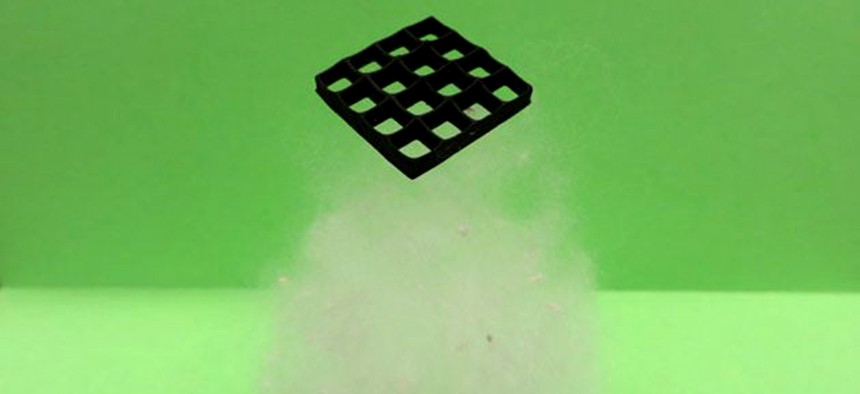You Can Now 3-D Print One of the World’s Lightest Materials

This 3D printed material rests gently on a piece of cotton fluff. Kansas State University and the State University of New York at Buffalo
This technology will make the material much easier to use, and open it up to wider applications.
Aerogels are among the world’s lightest materials. Graphene aerogel, a record holder in that category, is so light that a large block of it wouldn’t make a dent on a tiny ball of cotton. Water is about one thousand times more dense. The minimal density of aerogels allows for a number of possible applications, researchers have found, ranging from soaking up oil spills to “invisibility” cloaks.
Now, scientists from State University of New York at Buffalo report in the journal Small that they have found a way to 3-D print graphene aerogel, which has only been used in lab prototypes. This technology will make the material much easier to use, and open it, and hopefully other aerogel materials, up to wider applications.
Graphene is just a single layer of carbon atoms. Since it was isolated for the first time in 2004, it has been touted as a wonder material for its strength, pliability and conductivity. Aerogel is essentially a gel where the liquid is replaced by air. Graphene aerogel is known to be highly compressible (so it can bear pressure without breaking apart) and highly conductive (so it can carry electricity efficiently). The very structure of the material that gives it these properties, however, makes it difficult to manufacture using 3-D printing technology.
Typically, to 3-D print aerogel, the core material is mixed with other ingredients, such as a polymer, so that it can be pushed out using inkjet printers. Once the structure is made, the polymer is removed by a chemical process. In the case of graphene aerogel, however, doing this destroys its delicate structure.
SUNY Buffalo researchers came up with a solution. They mixed graphene oxide—graphene with extra oxygen atoms—with water and deposited layers on a surface at -25°C. This instantly froze each layer, and allowed the undisrupted construction of the aerogel, with ice as its support.
Once this process was completed, the ice was removed using liquid nitrogen in a “freeze drying” technique. This expelled the water without damaging the microstructure. The material was then heated to remove oxygen atoms, which left only graphene in the aerogel. The resulting solid had densities ranging from 0.5 kg per cubic meter to 10 kg per cubic meter. The lightest aerogel ever produced is about 0.16 kg per cubic meter (compared to 1,000 kg per cubic meter for water).
3-D printing of materials is becoming crucial for translating technology into industrial applications. 3-D printers create objects in the exact shape and form as needed, which helps with rapid prototyping and adoption of new technologies. For instance, 3-D printing has helped the aerospace industry to innovate more quickly on new models but also build parts for old models that are no longer being manufactured.
SUNY Buffalo researchers are now looking to expand their 3-D printing technology to build other types of aerogels.





